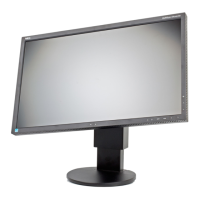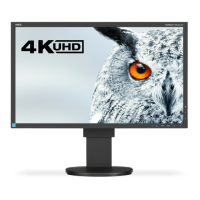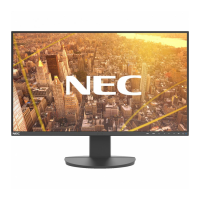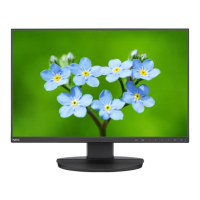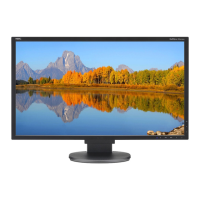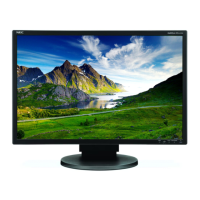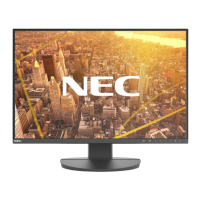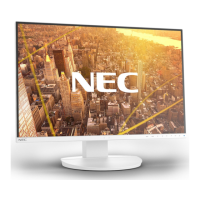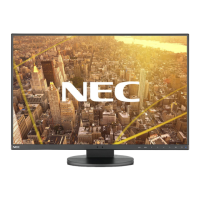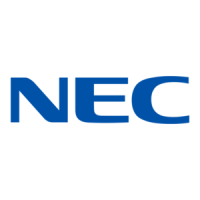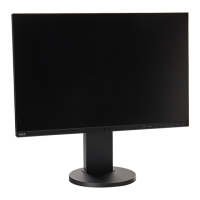Do you have a question about the NEC MultiSync EA244WMi and is the answer not in the manual?
| 3D | No |
|---|---|
| HD type | - |
| Aspect ratio | 16:10 |
| Screen shape | Flat |
| Response time | 6 ms |
| Backlight type | W-LED |
| Display diagonal | 24 \ |
| Display resolution | 1920 x 1200 pixels |
| Display technology | LED |
| Contrast ratio (dynamic) | 25000:1 |
| Contrast ratio (typical) | 1000:1 |
| Display number of colors | 16.78 million colors |
| Digital vertical frequency | 56 - 60 Hz |
| Digital horizontal frequency | 31.5 - 77 kHz |
| Display brightness (typical) | 350 cd/m² |
| Supported graphics resolutions | 1920 x 1200 (WUXGA) |
| TV tuner integrated | Yes |
| Power consumption (economy mode) | 16 W |
| USB hub version | 2.0 |
| DVI-I ports quantity | 0 |
| USB Type-A downstream ports quantity | 4 |
| RMS rated power | 2 W |
| Number of speakers | 2 |
| Pivot angle | 0 - 90 ° |
| LED indicators | Power |
| Tilt angle range | -5 - 30 ° |
| Cable lock slot type | Kensington |
| Panel mounting interface | 100 x 100 mm |
| Power consumption (max) | 29 W |
| Annual energy consumption | 31 kWh |
| Power consumption (standby) | - W |
| Power consumption (typical) | 21 W |
| Power consumption (PowerSave) | 0.47 W |
| Certification | CE; Energy Star 6.0; FCC Class B; GEEA/Energy Label; ISO 9241-307 (pixel failure class I); MPR III; PCT/Gost; RoHS; TCO 6.0; TCO Certified Edge Displays 1.2.; TÜV Ergonomics; TÜV GS; UL/C-UL or CSA |
| Product color | Black |
| Sustainability certificates | EPEAT Gold, ENERGY STAR |
| Operating temperature (T-T) | 5 - 35 °C |
| Operating relative humidity (H-H) | 20 - 80 % |
| Cables included | AC, DisplayPort, USB |
| Depth (with stand) | 230 mm |
|---|---|
| Height (with stand) | 408.9 mm |
| Weight (with stand) | 7500 g |
| Depth (without stand) | - mm |
| Width (without stand) | 556.2 mm |
| Weight (without stand) | - g |
Prevents fire or shock hazards by avoiding rain, moisture, and improper plug use.
Reduces risk of shock by unplugging unit, no user-serviceable parts inside.
States compliance with Canadian ICES-003 and C-UL standards.
Details FCC rules for radio frequency energy, interference, and conformity.
Covers Do Not Open, liquid spills, objects in slots, heavy objects on cords, unstable placement.
Outlines conditions requiring immediate service, like damaged stand, cord, or liquid exposure.
Explains residual images and how to prevent/alleviate them.
Advice on monitor placement, eye strain reduction, posture, and screen settings.
How to clean the LCD panel gently with a soft, lint-free cloth.
Procedures for cleaning the monitor cabinet using a soft cloth and mild detergent.
Lists the MultiSync monitor, power cord, video signal cables, USB, audio, and ControlSync cables.
Step-by-step instructions for connecting DVI, Analog, MAC, and DisplayPort.
Guide on connecting cables, tilting the screen, and powering on the monitor.
Organizing cables and verifying monitor movement after installation.
Instructions for powering on the monitor and using the auto-adjust function.
How to raise or lower the monitor screen to the desired height.
Procedure for rotating the screen between landscape and portrait modes.
How to adjust the monitor's tilt and swivel for optimal viewing.
Instructions on how to prepare the monitor for mounting on a flexible arm.
Step-by-step guide to detach the original monitor stand.
Using screws to attach a flexible arm to the monitor for mounting.
Information on VESA holes for adjusting monitor head position and potential functional impacts.
Explains the function of each button on the monitor's front panel.
Introduces Brightness, Contrast, and Eco Mode for power saving and display adjustments.
Details automatic brightness adjustment and power saving modes based on environment and activity.
Explains human presence detection for power saving and various visual modes for content.
Covers auto-adjust, position, size, and fine-tuning for analog inputs.
Explains selecting resolutions and adjusting color presets like sRGB and NATIVE.
Adjustments for volume, sound input, video level, over scan, and video detection.
Settings for expansion mode, response improvement, timers, LED brightness, and factory reset.
Settings for language, OSD timeout, lock-out, hot keys, and key guide display.
Covers copying settings between monitors (ControlSync) and saving/restoring custom configurations.
Details carbon footprint, cost savings, and currency settings for ECO information.
Explains OSD warnings like 'NO SIGNAL' and 'OUT OF RANGE', and where to find technical data.
Details LCD module, input signals, display colors, sync, viewing angle, and image formation time.
Lists supported resolutions, USB hub, audio inputs/outputs, and power supply details.
Provides physical dimensions, weight, and operating environmental considerations.
Details LCD module, input signals, display colors, sync, viewing angle, and image formation time.
Lists supported resolutions, USB hub, audio inputs/outputs, and power supply details.
Provides physical dimensions, weight, and operating environmental considerations.
Highlights DisplayPort, HDMI, Color Control Systems, and OSD controls for enhanced display management.
Covers ErgoDesign, Plug and Play, Intelligent Power Manager, and VESA mounting for user experience.
Details sRGB, Human Sensor, NaViSet software, HDCP compliance, and ControlSync capabilities.
Solutions for no display, unresponsive power key, and issues with power save timer.
Addresses image persistence, out of range messages, unstable images, and brightness issues.
Solutions for no video/sound, brightness fluctuations, and USB hub malfunctions.
Guidance for issues with human sensor and ControlSync connectivity.
Procedures for setting the maximum and minimum brightness levels for auto adjustment.
Explains how ambient light affects screen brightness and the role of brightness range settings.
Steps to connect master and sub monitors using ControlSync for synchronized settings.
Lists OSD settings that can be managed across multiple monitors using ControlSync.
Information on TCO Certified as a sustainability certification for IT products.
Details on Corporate Social Responsibility, Energy Efficiency, and other criteria for certification.
Guidance on proper disposal of old NEC products and recycling procedures.
Details the monitor's energy saving capabilities and power consumption modes.
